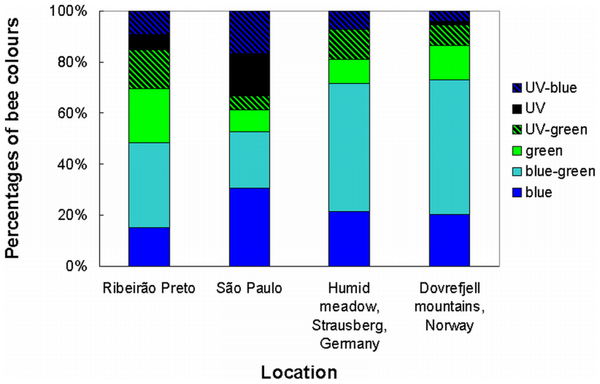Researchers at Queen Mary, University of London and Imperial College London have developed what they call FReD – the Floral Reflectance Database – that holds data on what colors flowers appear to be, to bees. Records of flower colors don't take the visual systems of pollinator insects into account and bees have evolved completely different color detection mechanisms from humans so they see colors outside our own capabilities in the ultra-violet range.
The research team have measured the spectral reflectance of a number of flowers in different locations and analyzed what bumblebees perceive, including different shades of ultraviolet. The image above shows a photograph of a creeping Zinnia (Sanvitalia procumbens) using a UV filter, giving just one example of the colors that are 'hidden' to us.
The database is freely searchable and open for international contribution, and will inform future ecological studies. "The records can be used to link flowers together by color, although they appear different to us. On a global scale we will be able to identify the colors preferred by pollinators and see how this varies. This is very significant in terms of the global food supply, which relies on these insects and bees in particular.

Color compositions of flora from different worldwide locations. The graph shows the relative percentages of plant species with flowers of different bee colors in four different locations: Ribeirão Preto, Brazil; São Paulo, Brazil; Strausberg, Germany and the Dovrefjell mountains, Norway [1], [33]. The differences between the four locations are significant (χ2 test, χ2 = 42.3, p = 0.0002), but notably, plants with flowers of at least five out of six arbitrary bee colors are present at all locations, suggesting that in all habitats, selection is likely to result in the presence of a range of flower colors.
Co-author Professor Vincent Savolainen, from the Department of Life Sciences at Imperial College London, who holds a joint post at the Royal Botanic Gardens, Kew, added, "We hope this work can help biologists understand how plants have evolved in different habitats - from biodiversity hotspots in South Africa to the cold habitats of northern Europe. FReD's global records may show how flower colour could have changed over time, and how this relates to the different insects that pollinate them, and other factors in their local environment."
Samia Faruq from the School of Electronic Engineering and Computer Science who is an expert in the computer modeling side of the project, said, "FReD provides over 2000 records with the colours that the bee sees presented in a very simple way. A successful flower has to be 'noticed' by the bee, and FReD provides a better understanding of the strategy flowers attain.
"Colour patterns emerging from the location or altitude in which flowers are found may in turn increase our understanding of the plant-pollinator relationship. We will also be able to determine if flower colours in a given location are converging or diverging in order to give themselves the best chance of reproducing."
Professor Peter McOwan, a computer scientist who helped in developing the technical side of the project, commented, "This combination of biology and computer science, allowing scientist to collaboratively access important data in new ways shows the power of combining these two scientific disciplines. This interdisciplinary approach can produce significant new applications that will help make a real impact in better understand the natural world."
Citation: Arnold SEJ, Faruq S, Savolainen V, McOwan PW, Chittka L (2010) FReD: The Floral Reflectance Database — A Web Portal for Analyses of Flower Colour. PLoS ONE 5(12): e14287. doi:10.1371/journal.pone.0014287






Comments